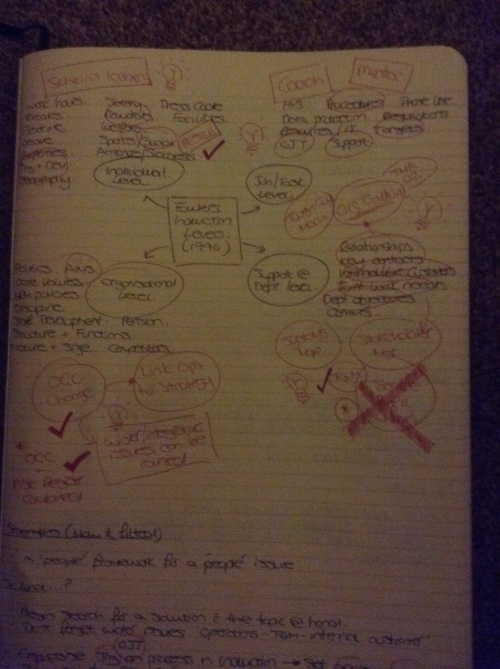Having spent ages trying to find a model to help change the behaviour of staff leaving the organisation (in order to help my project succeed) friends and colleagues helped me see that when you have a ‘people’ issue – look to the ‘people (hr) theories for a solution. It’s quite embarrassing really!
Fowler’s (1996) inductio levels suggests four key areas for consideration – individual, job/task level, support at depth level and organisational level. The sub-topics of each can be seen in my diagram above.
This model helped me to see the need to emphasise on the job training and set goals/provide rewards related to my project to new arrivals.
It also signpostedme to wider issues such as socialisation (from PESTLE) which will help build project team/stakeholder cohesion.
Retrospectively it helped me to see that the issues I had raised linked to the OGC Change Model (discussed/referenced in later post). Where i had/could use common reasons for project failure to surface levers, individualised leadership and social opportunities for stakeholder engagement/integration. This experience has been great in providing a nifty approach to risk management where the OGC reasons for project failure provide a trigger for me to identify risks and seek mitigating actions.
Areas where I had to work hard to ale the model fit the situation were; it is easy to get bogged down in the vast amount if sub- topics, presentation of the model as a list doesn’t help here. , as always not all areas of the model may be appropriate. On reflection I think if I were Fowler I would find a more creative way to present the model in order to do it more justice – it has been much more than just a list for me! And as with Morgan and Hunts (1994) trust model the need to seek wider business function links is quite tacit.
So what……
– I need to consult the model prior to every new induction, rather than having a one size fits all induction ‘tick sheet’ – you’ll know them we’ve all had to use them/create them in the past. Boring! But hone down the list.
– when trying to maintain project momentum look for larger strategic links to incentivise effort and reward the behaviour you want to see so that it sticks and the message gets out to others
– identifying stakeholders and opportunities for joint working (where a project relates) is soooo important!
– always look to consider the wider business functions, they surface so much helpful info in planning action.
– consider presentation and how it can be adapted to capture interest. List aren’t great are they!
So there it is my second review of an applied model with a ‘real life’ Jonathan Miller example of its use. Struggling to find any related business examples so if you see/hear of any let me know – I’d be very grateful. I’ll keep looking in the meantime (it’s like writing to ‘dear diary’). 🙂

